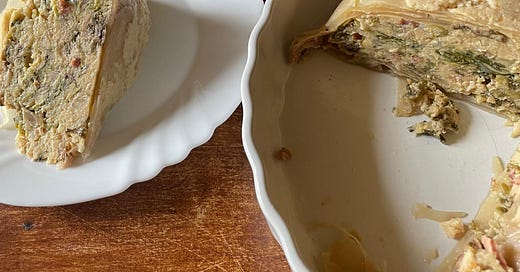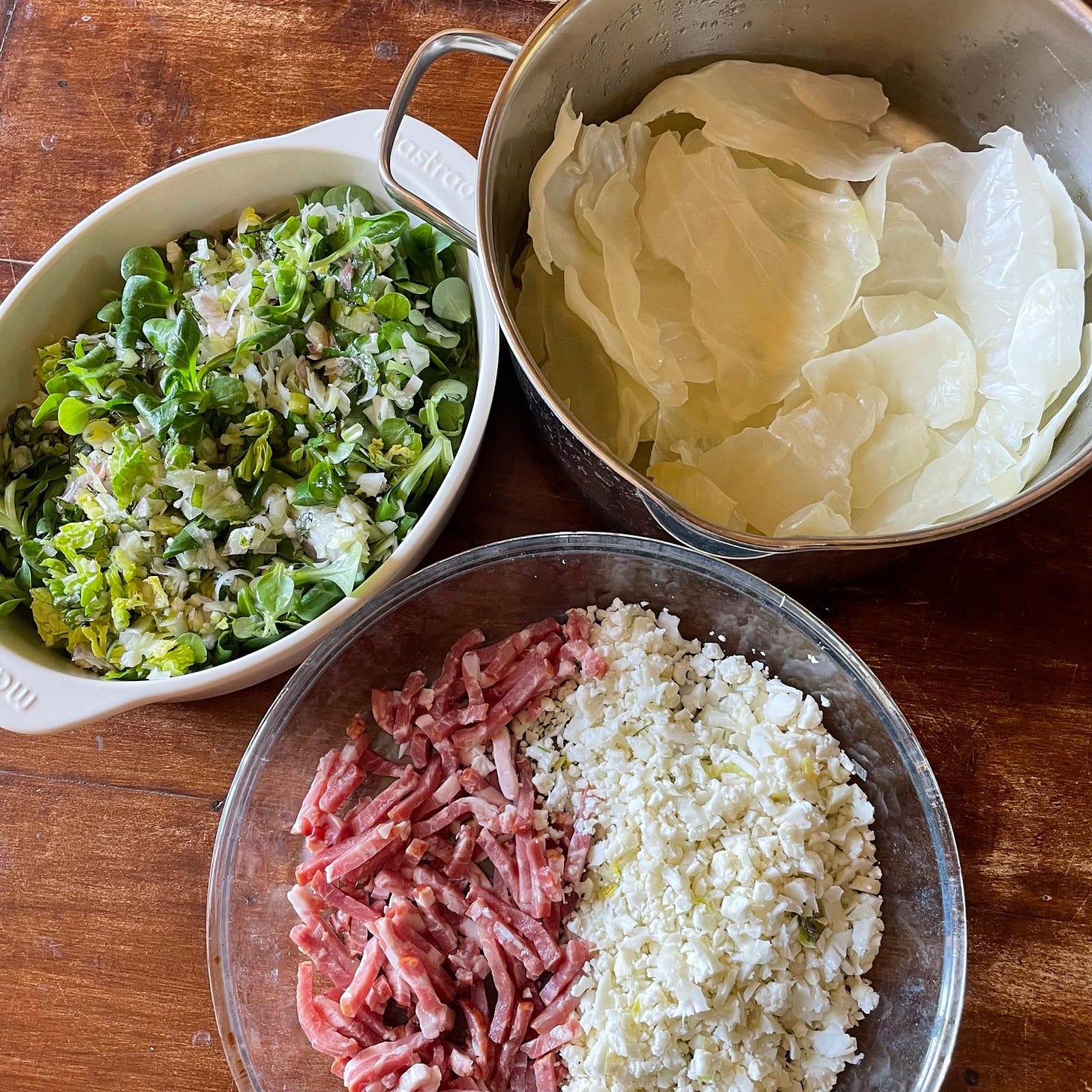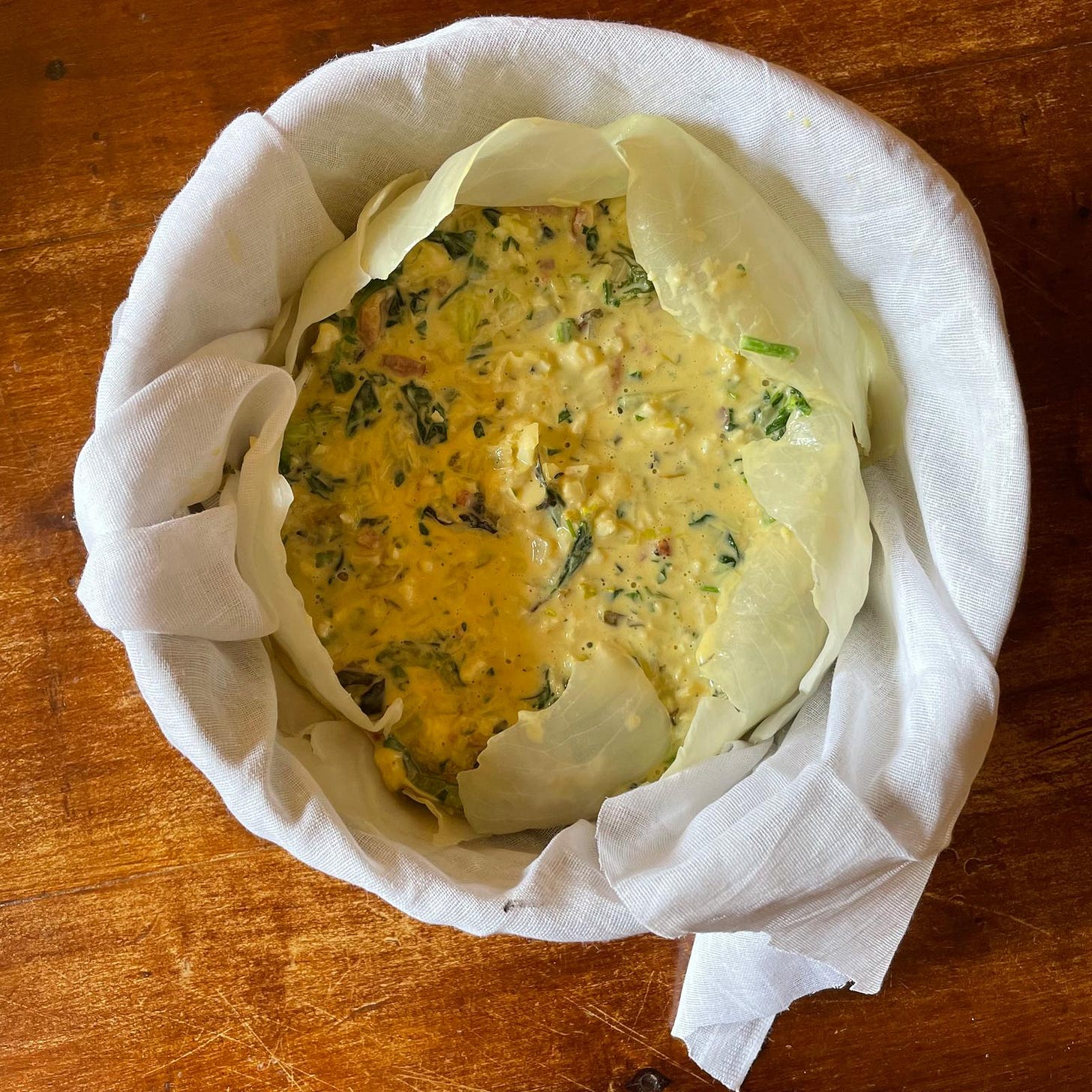Sometimes I practise what I term ‘Method Writing’™ – living and working in the style of the period concerned. Such as eating like a Neolithic farmer for Woodston, my history of English farming. My diet then included nettle pudding -Neolithic farmers did not see foraging and farming as mutually exclusive- which is the oldest known dish of the British. Researchers from the University of Wales Institute have found traces of nettle pudding 8,000 years old; Neolithic cooks blended the nettles with barley flour, other greens, salt and water to make a big dumpling/pudding to go into stews.
God that pudding was good, and it was filling. I am always put in mind of this classic of prehistoric cuisine when preparing the French peasant dish farci poitevin, which is its direct heir. A traditional dish of the rural poor of the Poitou region of western France since the Middle Ages, farci poitevin is a boiled savoury pudding which utilises leftovers. There are, though, certain staple ingredients - notably the cabbage leaves which form the casing and the handful of sorrel. Sometimes the farci is referred to as ‘herb pâté’, which accurately captures the generous ‘herbing’ required, less so the near mandatory inclusion of salted pork and the manner of consumption. Farci poitevin is served in satisfying supple slices and wedges, not spread on bread. ‘Farci’ is a time-wrangled corruption of the Latin farcire, ‘stuffing.’
Sorrel? The French have a real taste for the herb but you will struggle to find it in Britain, unless you forage for it in old meadows (themselves a rarity), or grow it. It has a distinct acidic, lemony tang – farmworkers of old would chew a sorrel leaf to precipitate saliva when haymaking. A substitute is spinach with a dash of lemon. If farci poitevin has left its humble origins in the rural kitchen – today it’s a familiar starter in restaurants and middle class homes- it has not translated from its birthplace. It is near unknown outside the region of Poitou. Farci Charentais is similar, but excludes cabbage leaves.
Recipe
Number of people 6-8
Prep time 30 minutes
Cooking time 4 hours
Ingredients
Essential:
750 g sorrel
500 g organic/free range fatty bacon (diced)
15 cabbage leaves
6 free range eggs
20 cl cream
200g flour
1.5 litres vegetable or chicken stock
olive oil/butter
The eggs and flour are necessary to bind everything together. The rest of the ingredients can be -indeed, should be- adjusted to the season and what lingers and lurks in the fridge and veg rack. The following assembly works well:
Half a bunch of parsley, 2 sprigs thyme, a fistful of chives, the whites of 4 leeks, 500 g spinach, 1 lettuce heart, a third of a cauliflower, 2 shallots, 2 cloves of garlic, 3-5 sprigs of savoury, salt, pepper. If in doubt, herb it up
.
Method: Blanch the leaves of cabbage, and place to one side. White cabbage is less leak-proof, while green provides a more attractive appearance.
Chop shallots , garlic, leeks and sauté in olive oil or butter.
Put a cauldron -or similar- of stock onto boil.
Chop up the remaining vegetable and herbs, having previously washed and drained them. Place in a large salad bowl. Add the sautéed ingredients, the eggs, the flour, the bacon, the cream. Season. Mix everything thoroughly with your hands.
Place a greased muslin cloth in a colander or deep dish, and line with the cabbage leaves so that they overlap. Pour in the prepared mixture, and close with leaves. The preparation should be entirely wrapped in blanched cabbage. Fold over the muslin and tie very tightly with string
.
Plunge the farci into the boiling broth, so that the bacon and eggs cook quickly. Reduce the heat to a simmer. Cook for four hours, adding boiling water if necessary.
To serve. Remove from water, place on a dish, untie the muslin and put a plate on the uppermost side of the farci. Invert and remove the muslin. Farci poitevin may be eaten hot or cold. It is tastier cold. But on a winter’s day a piping hot wedge of farci poitevin is a comfort food ‘sans pareil’.
.









